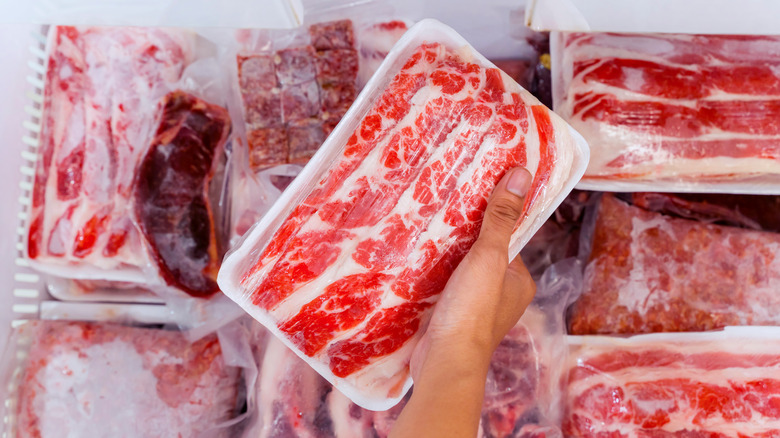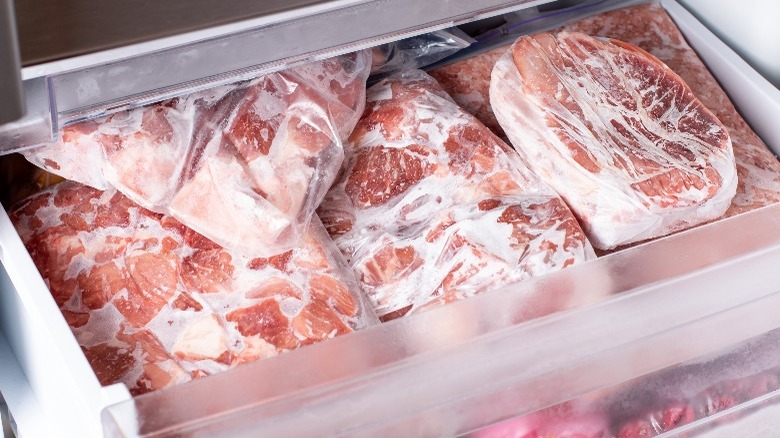The Main Reason Meat And Seafood Shouldn't Be Frozen Twice
Putting a package of chicken, fish, shrimp, or any other meat or seafood into the freezer is a great way to preserve those meals if you're not going to cook them any time soon. However, you might want to check the labels on those items and see if they've already been frozen. Likewise, you should probably commit to eating meat that has already thawed out in the fridge. Although eating previously frozen meat won't harm you, the food will lose its structural integrity and become mushier and less enjoyable.
The moisture that would otherwise create bacteria and degrade food becomes frozen solid when exposed to low temperatures in a freezer. However, water also expands and becomes crystalline as it freezes, pushing against and stabbing into the cellular tissue that binds meat together. All those cells that have ruptured leak out moisture when the meat heats up again, which is why a steak looks extra wet after it has been thawed out. That's not a problem after the first round of freezing, and a study from Kansas State University concluded that this process could actually help to tenderize meat. However, if carried out multiple times, it can cause the meat to lose its firmness and dry out.
Crystallization and its discontents
Crystallization is the key word to understanding why re-freezing meat can dry and oversoften it. Water molecules don't freeze into a neat, rounded shape (unlike those satisfying whiskey ice spheres would have you believe). Rather, they turn into microscopic crystals that only get pointier the more moisture from the surrounding air they come into contact with. The crystals continue to grow and further puncture the muscle of the meat until they thaw out and leave behind a puddle of water and meat juice. That additional liquid is an even riper environment for crystallization to occur when re-freezing meat, eventually leading to an off texture, color, and taste.
There are ways to prevent the sponginess that comes with re-freezing meat. Obviously, the most effective measure is to just cook anything that you thaw out in the fridge within three days, but mistakes happen, cooking schedules change, and suddenly you don't have time to fry that pork chop you were planning on having tonight. Packing your meat properly by vacuum-sealing can help mitigate the process of losing moisture when thawed out, especially in preventing the nasty-tasting freezer burn that occurs when cold, dry air creates a plague of ice crystals that cover entire portions of your cuts.
Some rules about thawing
There are a couple of caveats about re-freezing that will determine the quality of the thawed meat. The no re-freeze rule is especially strict in the case of fish since there's a harmful bacteria that can grow even in vacuum-sealed conditions of seafood and cause the scary nerve disease known as botulism. It's rare, but it's probably best to stay on the safe side and take the fish out of the vacuum seal before thawing it out since exposure to oxygen kills the bacteria. That does mean, however, that fish truly gets only one chance to thaw out.
Flash-freezing is, by far, the most surefire way to prevent meat from becoming too soft after thawing out. The rapid temperature drop that quickly freezes meats in this process means that the ice crystals don't have enough time to tear through the cell walls. If your meat has been flash-frozen before purchase, it's vastly more protected against the effects of re-freezing and re-thawing. Finally, it's important to remember to avoid thawing meat out at room temperature since bacteria can quickly grow on the outer layer as the inside remains cold. Never re-freeze meat that has been sitting out of the fridge for more than two hours. Not only will this degrade the meat, but it's also positively dangerous for your health.



